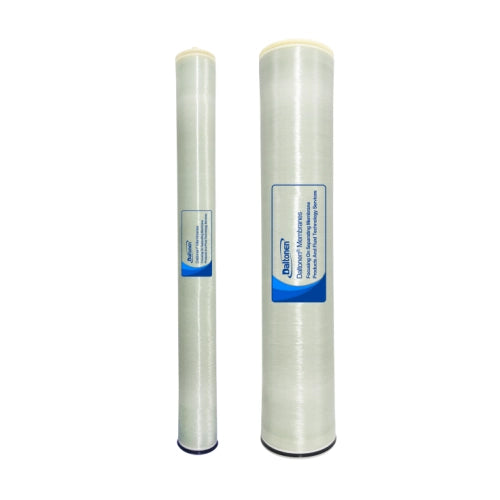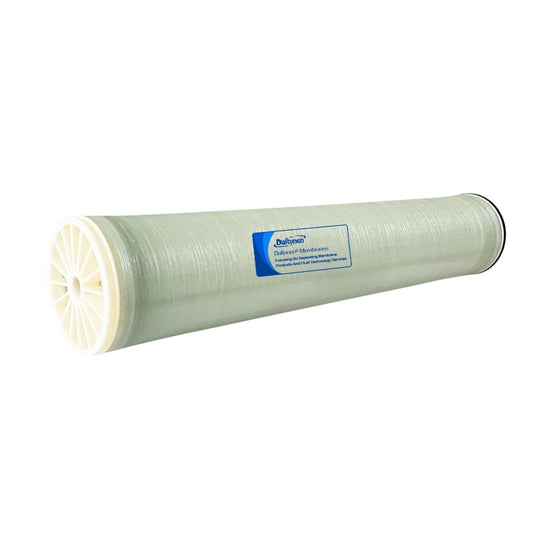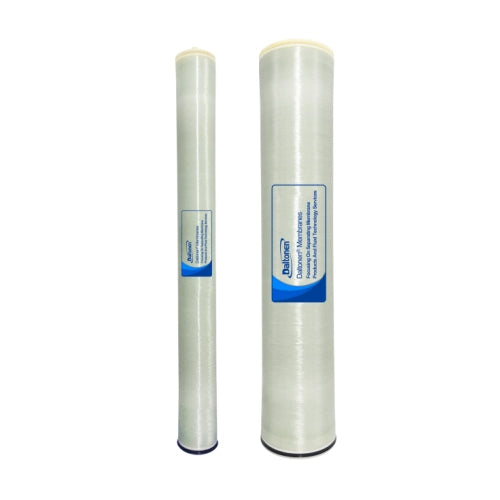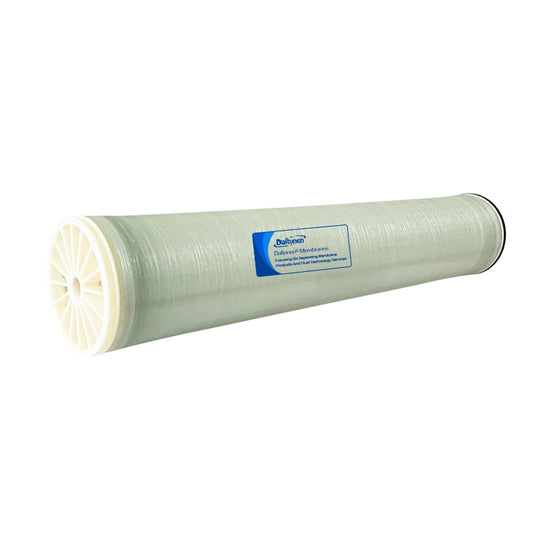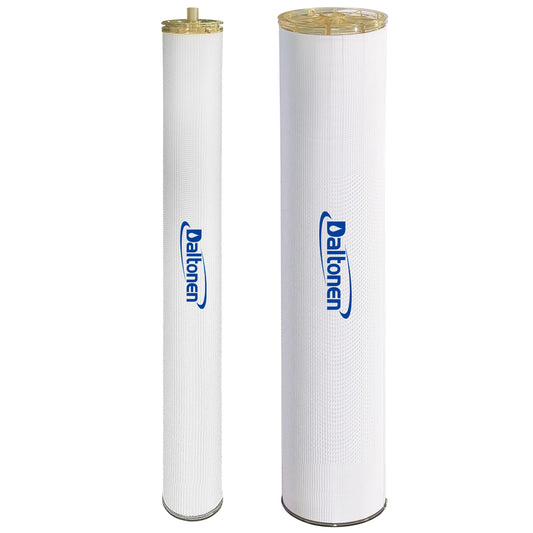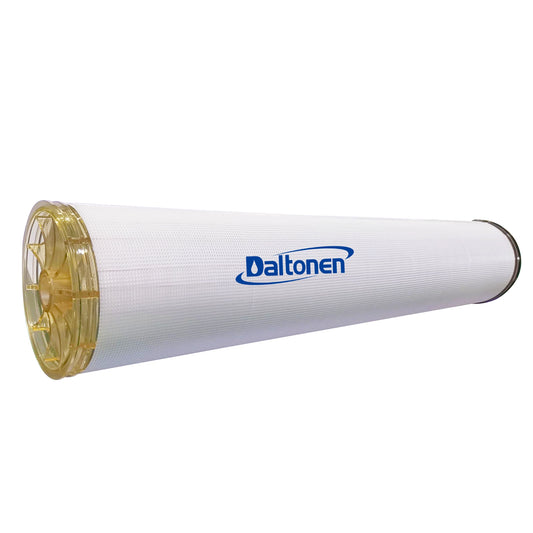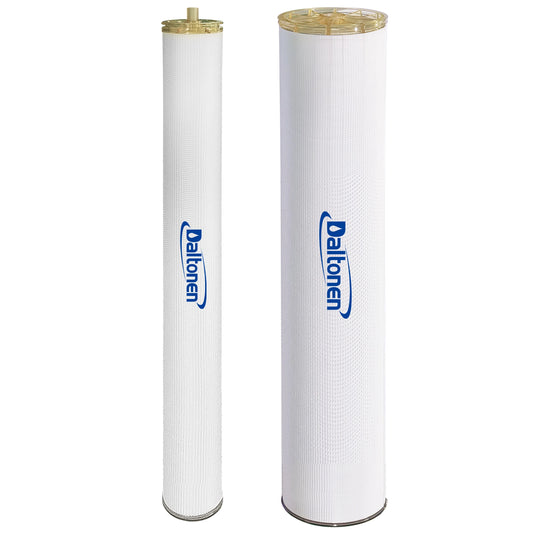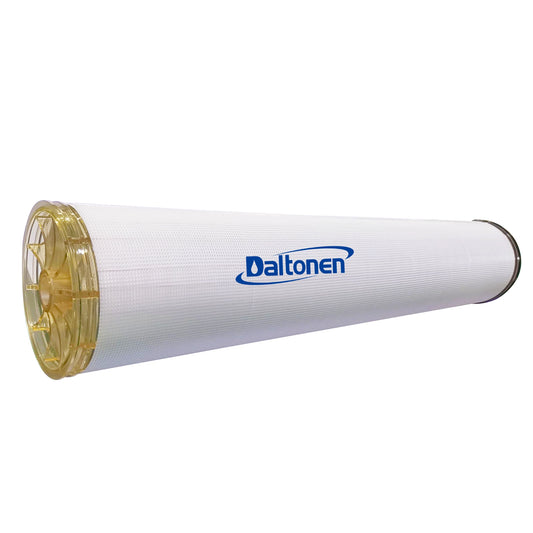The Application of Reverse Osmosis Membrane Technology in Desalination of Seawater
The Application of Reverse Osmosis Membrane Technology in Desalination of Seawater
1. Principle of Reverse Osmosis Membrane Desalination Technology
1.1 Pressure Difference Drives Solvent Separation
The core of reverse osmosis membrane desalination technology lies in using pressure difference to drive the separation of solvent (water molecules) from solute (salts and other impurities). Reverse osmosis membranes are semipermeable membranes with extremely small pore sizes, typically ranging from 0.0001 micrometers to 10 nanometers. These membranes allow water molecules to pass through while effectively blocking salts, organic substances, bacteria, viruses, and other impurities.
In the natural osmosis process, the solvent spontaneously flows from a region of low concentration to a region of high concentration, forming osmotic pressure. Reverse osmosis technology, however, applies a pressure greater than the osmotic pressure, causing the solvent to flow in the opposite direction, from the high-concentration region (seawater) to the low-concentration region (freshwater). The driving force for this process is the pressure difference, which depends on the hydrostatic pressure difference (Δp) and the osmotic pressure difference (Δπ) between the two sides of the membrane. This can be represented by the formula N = Kh(Δp - Δπ), where Kh is the hydraulic permeability coefficient.
In the desalination of seawater, reverse osmosis membranes typically use asymmetric or composite membranes, which have high desalination rates and good durability. For example, aromatic polyamide composite membranes are currently the most widely used type of reverse osmosis membrane, with a desalination rate exceeding 99%. These membranes can effectively remove various ions and impurities from seawater. Through this pressure-driven separation process, seawater is pushed into the reverse osmosis membrane system by high-pressure pumps. Water molecules pass through the membrane into the low-pressure side to form freshwater, while salts and other impurities are retained on the high-pressure side as concentrate.
The advantages of this technology include its high efficiency, energy-saving nature, and environmental friendliness. Compared with traditional distillation methods, reverse osmosis technology significantly reduces energy consumption, saving approximately 40% to 60% of energy. Moreover, the lifespan of reverse osmosis membranes is generally 3 to 5 years, and with continuous technological advancements, their performance and durability are also improving.

2. Application Fields
2.1 Water Supply for Island Living
Reverse osmosis membrane desalination technology has significant application value in providing water for island living. Islands typically lack freshwater resources, and traditional methods of obtaining water, such as rainwater collection and groundwater extraction, are insufficient to meet the daily needs of residents. Reverse osmosis membrane technology offers a stable and reliable source of freshwater for island communities.
Case Study: Yongxing Island, Sansha City, China
In 2016, Yongxing Island in Sansha City built a seawater desalination facility with a daily production capacity of 1,000 cubic meters, using a two-stage reverse osmosis system. After pretreatment, seawater enters the reverse osmosis system. The first-stage product water is used for general domestic purposes, such as laundry and bathing, while the second-stage product water is used for drinking and cooking. After more than a year of operation, the water quality remained stable and met the "Hygienic Standard for Drinking Water" (GB5749-2006). This effectively solved the water supply problem for the military and civilians on the island.
Technical Advantages
Reverse osmosis membrane desalination technology demonstrates high efficiency and energy savings in island applications. For example, the desalination facility on Yongxing Island used an energy recovery system, reducing energy consumption by about 60% compared to traditional desalination technologies. Additionally, reverse osmosis membranes have strong resistance to pollution and a long lifespan, making them suitable for the complex seawater quality found on islands.
Social Impact
The application of this technology not only improves the quality of life for island residents but also reduces dependence on mainland freshwater resources, promoting sustainable development of the island. Moreover, the successful application of reverse osmosis membrane desalination technology on Yongxing Island provides valuable experience for other water-scarce islands.
2.2 Industrial Water for Coastal Cities
The demand for industrial water in coastal cities is enormous, while freshwater resources are relatively scarce. Reverse osmosis membrane desalination technology offers an effective solution to this contradiction. In the industrial sector, high-quality freshwater is crucial for production processes, and reverse osmosis membrane technology can provide freshwater that meets industrial standards, satisfying the water needs of various industries.
Water Quality Advantages
Water treated by reverse osmosis membranes is pure, effectively removing inorganic salts, heavy metal ions, organic substances, bacteria, and other harmful components from seawater. For example, in a seawater desalination project in a coastal city, the key indicators such as chemical oxygen demand (COD), biochemical oxygen demand (BOD), and total dissolved solids (TDS) in the treated water were all below national industrial water standards.
Economic Analysis
Compared with traditional thermal desalination technologies, reverse osmosis membrane technology consumes less energy and has lower operating costs. For example, a seawater desalination device in a coastal city had an electricity consumption of 3.7 kilowatt-hours per ton of water produced, with a local electricity price of 1.8 yuan per kilowatt-hour. The use of an energy recovery device reduced the system's energy consumption by about 60% compared to previous desalination projects without such devices, and the cost per ton of water produced also decreased by about 40%.
Process Flexibility
Reverse osmosis membrane seawater desalination equipment is characterized by its simple process, easy operation, and convenient maintenance, making it suitable for large-scale promotion and application. Additionally, the compact structure of the equipment means it occupies less space and can be installed in narrow areas such as engine rooms, decks, cabins, and corridors. This is particularly significant for coastal cities with limited land resources.
Industry Applications
Reverse osmosis membrane desalination technology has been widely applied in the industrial sectors of coastal cities. For example, in the petrochemical industry, water treated by reverse osmosis membranes meets the standards for water discharge or reuse, improving the overall economic benefits of enterprises. In the textile industry, the combination of reverse osmosis membranes and ultrafiltration can deeply treat textile wastewater with very poor biodegradability, effectively removing refractory organic substances.

3. Technical Advantages
3.1 High Desalination Rate and Water Quality Assurance
One of the core advantages of reverse osmosis membrane desalination technology is its extremely high desalination rate and excellent water quality assurance. According to research, the desalination rate of the widely used aromatic polyamide composite membranes can exceed 99%. This means that almost all salts and other impurities can be effectively removed during the seawater desalination process, ensuring that the produced freshwater is pure and meets or even exceeds national drinking water standards.
For example, in the seawater desalination project on Yongxing Island in Sansha City, China, the use of a two-stage reverse osmosis system resulted in stable water quality that met the "Hygienic Standard for Drinking Water" (GB5749-2006). Key indicators such as chemical oxygen demand (COD), biochemical oxygen demand (BOD), and total dissolved solids (TDS) were all significantly below national standards. This high desalination efficiency is not only applicable to island living water but also plays an important role in industrial water for coastal cities.
Additionally, reverse osmosis membrane technology can effectively remove organic substances, bacteria, viruses, and other microorganisms from seawater, ensuring water safety. In some applications, water treated by reverse osmosis membranes can even be directly used for high-demand industrial production, such as the preparation of ultrapure water in the electronics industry. This high desalination rate and water quality assurance make reverse osmosis membrane desalination technology stand out among numerous seawater desalination methods and become an important solution to water scarcity problems.
3.2 Energy Saving and Economic Viability
Another significant advantage of reverse osmosis membrane desalination technology is its energy-saving and economic nature. Compared with traditional distillation methods, reverse osmosis technology consumes significantly less energy, saving approximately 40% to 60% of energy. This energy-saving effect is primarily due to the working principle of reverse osmosis membranes, which drive solvent separation through pressure differences rather than relying on high-energy-consuming thermal energy.
In practical applications, the economic viability of reverse osmosis membrane desalination technology has been fully demonstrated. For example, a seawater desalination device in a coastal city had an electricity consumption of 3.7 kilowatt-hours per ton of water produced, with a local electricity price of 1.8 yuan per kilowatt-hour. The use of an energy recovery device reduced the system's energy consumption by about 60% compared to previous desalination projects without such devices, and the cost per ton of water produced also decreased by about 40%. This energy-saving effect not only reduces operating costs but also enhances the economic viability of the system.
Moreover, the lifespan of reverse osmosis membranes is generally 3 to 5 years, and with continuous technological advancements, their performance and durability are also improving. This means that in long-term operation, reverse osmosis membrane desalination technology can maintain stable performance and lower maintenance costs. For example, in the seawater desalination project on Yongxing Island in Sansha City, the use of an energy recovery system significantly reduced energy consumption and operating costs. This economic and energy-saving effect makes reverse osmosis membrane desalination technology widely applicable in island living water and industrial water for coastal cities.
4. Process Flow
4.1 Pretreatment Stage
The pretreatment stage is a key step in ensuring the stable and efficient operation of reverse osmosis membrane desalination technology. The main purpose of pretreatment is to remove suspended solids, colloids, microorganisms, organic substances, and hardness ions from seawater, reducing pollution and fouling of the reverse osmosis membranes. The pretreatment stage typically includes the following steps:
Coarse Filtration: Seawater passes through sand filters or multi-media filters to remove large suspended particles, reducing the pressure on subsequent precision filtration equipment. For example, multi-media filters use layered materials such as anthracite and quartz sand to remove larger particles from the water based on the principle of depth filtration.
Flocculation and Coagulation: Flocculants are added to encourage the formation of larger flocs from small particles in the water. These flocs can then be separated from the water in sedimentation or clarification tanks, effectively reducing suspended solids and some colloidal substances. Common flocculants include aluminum sulfate and polyaluminum chloride.
Precision Filtration: Precision filters, such as activated carbon filters or security filters, are used to remove dissolved organic substances, residual chlorine, and finer particles. This step protects the reverse osmosis membranes from organic pollution and extends their lifespan. For example, activated carbon filters can remove large molecular organic substances, colloids, odors, residual chlorine, and other impurities from the water.
Water Softening: For hard water sources, ion exchange resins or lime softening methods are used to reduce water hardness. This prevents the deposition of calcium and magnesium ions on the reverse osmosis membranes, which could form scale and reduce membrane flux. For example, sodium ion exchange softening can effectively adsorb hardness components such as Ca²⁺ and Mg²⁺ from the water.
Disinfection and Sterilization: Chlorine, ozone, or other oxidizing agents are used to disinfect and sterilize the water, eliminating microorganisms that could cause biological fouling and degradation of the membrane components. For example, common disinfectants such as chlorine gas and sodium hypochlorite can effectively kill bacteria and algae in seawater.
Optimizing the pretreatment stage is crucial for the performance of the entire reverse osmosis system. Accurate chemical dosing, regular equipment maintenance, and establishing a comprehensive online water quality monitoring system are important measures to ensure effective pretreatment. For example, real-time monitoring of water quality changes and adjustment of chemical dosing can significantly improve pretreatment efficiency.
4.2 Reverse Osmosis Process
The reverse osmosis process is the core stage of seawater desalination. It involves applying high pressure to force water molecules through the reverse osmosis membrane while retaining salts and other impurities. The specific steps of the reverse osmosis process are as follows:
High-Pressure Pumping: Pretreated seawater is pressurized by high-pressure pumps to reach the operating pressure required by the reverse osmosis membrane. The operating pressure of high-pressure pumps typically ranges from 3 to 5 megapascals, depending on the salinity of the seawater and the performance of the membrane.
Membrane Separation: The pressurized seawater enters the reverse osmosis membrane modules. Under the driving force of the pressure difference, water molecules pass through the membrane to form freshwater, while salts and other impurities are retained on the concentrate side. The pores of the reverse osmosis membrane are extremely small, usually ranging from 0.0001 micrometers to 10 nanometers, effectively blocking salts, organic substances, bacteria, viruses, and other impurities.
Freshwater Collection and Concentrate Discharge: Freshwater that passes through the membrane is collected and transported to subsequent treatment or storage systems, while the concentrate is discharged or further treated. In practical applications, the discharge of concentrate must comply with environmental requirements to minimize environmental impact.
System Optimization: To improve the efficiency and economic viability of the reverse osmosis system, energy recovery devices are often used to reduce energy consumption. For example, energy recovery devices can recover energy from the concentrate to reduce the energy consumption of high-pressure pumps. Additionally, optimizing the arrangement and operating parameters of the membrane modules can further enhance system performance.
The efficiency and stability of the reverse osmosis process directly affect the cost and water quality of seawater desalination. By properly designing and optimizing the reverse osmosis system, efficient and energy-saving seawater desalination can be achieved. For example, the Sorek Seawater Desalination Plant in Israel, which uses advanced reverse osmosis technology, has a daily production capacity of 620,000 cubic meters and is one of the largest reverse osmosis seawater desalination projects in the world.
5. Technical Challenges and Improvements
5.1 Membrane Fouling and Blocking Issues
Reverse osmosis membrane desalination technology faces significant challenges from membrane fouling and blocking in practical applications. Membrane fouling refers to the adhesion of organic substances, inorganic substances, and microorganisms from seawater to the membrane surface or pores, leading to decreased membrane flux, increased operating pressure, and higher energy consumption and operating costs. For example, in some island seawater desalination projects, membrane fouling is particularly prominent due to the high levels of algae, microorganisms, and organic substances in seawater, with a significant decline in membrane flux during the initial operation.
Types and Causes of Fouling
Organic Fouling: Seawater contains a large amount of organic substances, such as humic acids and algal exudates, which easily form a sticky film on the membrane surface, hindering the passage of water molecules. Research has shown that organic fouling can cause the membrane flux to decrease by 30% to 50% during the initial operation.
Inorganic Fouling: The deposition of inorganic salts on the membrane surface forms scale, especially the deposition of calcium, magnesium, and silicon ions, which severely reduces membrane performance. For example, the formation of silicon scale can lead to a decrease in membrane flux by more than 60%.
Biological Fouling: The rich microorganisms in seawater reproduce on the membrane surface, forming biofilms that not only block the membrane pores but also release metabolic products that further exacerbate membrane fouling. Biological fouling is one of the most difficult types of membrane fouling to control.
Solutions
Membrane Material Improvement: Developing new anti-fouling membrane materials is key to solving membrane fouling problems. For example, Professor Zhang Xuan's team at Nanjing University of Science and Technology developed a polyester-type reverse osmosis membrane. By introducing derivatives of resorcinol (DHMBA), the anti-fouling performance of the membrane was significantly improved. The surface roughness of this membrane material is only 2.36±0.32 nanometers, one order of magnitude lower than that of traditional polyamide membranes, effectively reducing the adhesion of pollutants.
Surface Modification Technology: By using surface coating or grafting techniques, anti-fouling properties can be赋予reverse osmosis membranes. For example, incorporating nanoparticles and grafting anti-biofouling agents can significantly enhance the membrane's resistance to biological fouling. Research has shown that the modified reverse osmosis membranes achieve sterilization rates of 97.3% against E. coli and 98.7% against Bacillus subtilis, far higher than traditional membranes.
Optimized Pretreatment: Enhancing the pretreatment process to remove most pollutants from seawater can alleviate the burden on the membranes. For instance, combining ultrafiltration with reverse osmosis can effectively remove suspended solids and large molecular organic substances from seawater, reducing the risk of membrane fouling. Additionally, regular cleaning of membrane components is an essential measure to prevent membrane fouling.
5.2 Energy Consumption Optimization
Optimizing the energy consumption of reverse osmosis membrane desalination technology is crucial for reducing operating costs and improving economic viability. The reverse osmosis process requires high pressure to drive water molecules through the membrane, resulting in relatively high energy consumption. For example, traditional reverse osmosis seawater desalination systems typically consume about 5 to 6 kilowatt-hours per ton of water produced. By optimizing system design and operating parameters, energy consumption can be significantly reduced.
System Design Optimization
Energy Recovery Devices: Implementing energy recovery devices is an effective way to reduce energy consumption. For example, the Sorek Seawater Desalination Plant in Israel achieved a 30% reduction in energy consumption by using energy recovery devices. These devices can harness energy from the concentrate to reduce the energy demand of high-pressure pumps.
Membrane Module Optimization: Properly designing the arrangement and operating parameters of membrane modules can enhance system efficiency. For instance, using multi-stage reverse osmosis systems can lower the operating pressure of individual stages and improve overall system efficiency. Additionally, optimizing the structure and materials of membrane modules can also reduce energy consumption.
Operating Parameter Optimization
Adjustment of Operating Pressure: Based on the salinity of the seawater and the performance of the membrane, adjusting the operating pressure can reduce energy consumption. For example, in areas with lower salinity, reducing the operating pressure can decrease energy consumption while maintaining a high water production rate.
Temperature Control: The temperature of seawater significantly affects the performance of reverse osmosis membranes. By controlling the seawater temperature, membrane flux can be increased, reducing energy consumption. For example, using a seawater preheating system can raise the seawater temperature to 25 to 30 degrees Celsius, thereby increasing membrane flux.
Intelligent Monitoring: Introducing intelligent monitoring systems to real-time monitor system operation and optimize operating parameters can reduce energy consumption. For example, using advanced sensors and data analysis technologies can monitor the degree of membrane fouling in real-time, enabling timely cleaning and maintenance to ensure the system operates at its best.
Utilization of Renewable Energy
Integrating renewable energy is an important direction for reducing the energy consumption of reverse osmosis membrane desalination technology. For example, using solar or wind energy-powered reverse osmosis systems can achieve energy savings and provide a stable water source in remote areas. Research has shown that solar-powered reverse osmosis seawater desalination systems have significant economic advantages in regions with ample sunlight.

6. Typical Application Cases
6.1 Seawater Desalination Project in Sansha City, China
The seawater desalination project on Yongxing Island in Sansha City is a successful example of reverse osmosis membrane desalination technology in island living water supply. The project was completed in 2016 with a designed production capacity of 1,000 cubic meters per day. It employs a water treatment process combining nanocatalytic electrolysis, sedimentation, ultrafiltration, reverse osmosis, and remineralization. The specific process is as follows:
Pretreatment: Seawater is drawn into a nanocatalytic electrolysis machine through the water intake system. The effluent from the electrolysis machine enters a lamella sedimentation tank and then passes through a columnar ultrafiltration system. The surface load of the sedimentation tank is 1.46 cubic meters per square meter per hour, and the ultrafiltration design flux is 30 liters per square meter per hour, with a recovery rate of 90%. This pretreatment method effectively removes suspended solids, colloids, and microorganisms from seawater, providing high-quality feedwater for the subsequent reverse osmosis process.
Reverse Osmosis Process: A combination of single-stage and two-stage reverse osmosis is used. The single-stage reverse osmosis is designed with a water production flux of 0.60 cubic meters per hour per module, with a maximum pressure of 6.5 megapascals. The two-stage reverse osmosis is designed with a water production flux of 0.90 cubic meters per hour per module, with a maximum pressure of 12.5 megapascals. This two-stage reverse osmosis system ensures that the desalinated water meets high standards, with the first-stage product water used for general domestic purposes and the second-stage product water used for drinking and cooking.
Remineralization: The desalinated water is treated with calcium chloride (CaCl₂) and sodium bicarbonate (NaHCO₃) for remineralization. By adjusting the pH value of the water and adding calcium and other minerals, the total alkalinity of the water is maintained at 80 milligrams per liter (as CaCO₃), and the total hardness is kept between 80 and 120 milligrams per liter (as CaCO₃). This ensures that the water is stable, non-corrosive, and meets drinking water standards.
Operation Results:
Water Quality Compliance: The water quality remains stable and meets the "Hygienic Standard for Drinking Water" (GB5749-2006), with good taste for drinking.
Energy Savings: The use of an energy recovery system results in an electricity consumption of 3 to 5 kilowatt-hours per cubic meter, significantly reducing energy consumption compared to traditional desalination technologies.
Social Benefits: The project effectively解决了the water supply problem for military and civilian personnel on the island, improved the quality of life for residents, reduced dependence on mainland freshwater resources, and promoted the sustainable development of the island.
6.2 Magtaa Seawater Desalination Plant in Algeria
The Magtaa Seawater Desalination Plant in Algeria is one of the largest seawater desalination projects in Africa and a typical application of reverse osmosis membrane desalination technology in large-scale urban water supply. The project was officially commissioned at the end of 2014 and was constructed and operated by Singapore's Hyflux. Its main features are as follows:
Production Capacity: The Magtaa Seawater Desalination Plant can supply 500,000 cubic meters of freshwater per day, meeting the water needs of 5 million people. This scale is of great significance not only in Africa but also globally, providing strong support for solving local water scarcity problems.
Technical Configuration: The project is equipped with the world's largest ultrafiltration pretreatment facility, and the reverse osmosis membranes used in the separation stage are from Toray, Japan. This advanced technical configuration ensures the high quality of desalinated water and the efficient operation of the system.
Cooperation Model: Hyflux signed a 25-year operations and maintenance contract with the local utility company, L'Algérienne Des Eaux, and the African oil and gas giant Sonatrach, worth 632 million Singapore dollars (approximately 495 million US dollars). This cooperation model not only ensures the long-term stable operation of the project but also promotes local economic development.
Chinese Enterprise Participation: China National Building Materials Group Corporation's subsidiary, China Composite United, provided fiberglass-reinforced plastic (FRP) pipes and installation services for the project, with a total length of nearly 30 kilometers. The participation of Chinese enterprises not only demonstrated China's technical capabilities in the field of seawater desalination but also set a new example for China-Africa cooperation.
Operation Results:
Water Quality Assurance: The desalinated water meets local drinking water standards, effectively solving the water needs of Oran and its surrounding areas.
Economic Viability: By optimizing pretreatment processes and reverse osmosis system design, operating costs were reduced, and the economic viability of the project was enhanced.
Social Impact: The successful operation of the project provides a stable water supply for local residents, improves their quality of life, and promotes social stability and development.
7. Technological Development Trends
7.1 Development of New Membrane Materials
The development of new membrane materials is a key direction for the advancement of reverse osmosis membrane desalination technology. The goal is to improve membrane performance, reduce costs, and enhance anti-fouling capabilities to meet the growing demand for seawater desalination.
Types and Characteristics of New Membrane Materials
Nanocomposite Membranes: By incorporating nanomaterials such as carbon nanotubes and nano-silica into traditional membrane materials, the mechanical strength and anti-fouling performance of the membranes can be significantly enhanced. For example, carbon nanotube composite membranes have a water flux 30% higher than that of traditional polyamide membranes, while maintaining excellent desalination performance.
Zwitterionic Membranes: These membranes introduce zwitterionic groups that can effectively reduce interactions between the membrane surface and pollutants, thereby reducing membrane fouling. Research has shown that the anti-fouling performance of zwitterionic membranes is more than 50% better than that of traditional membranes.
Graphene-Based Membranes: Graphene has excellent mechanical properties and chemical stability. Incorporating it into reverse osmosis membranes can significantly enhance membrane performance. Graphene-based membranes have a desalination rate of over 99.5% and good anti-fouling capabilities.
Research Progress and Application Prospects
Breakthroughs in High-Performance Membrane Materials: Significant progress has been made in the development of high-performance membrane materials in recent years. For example, Professor Guo Sheng's team at Nanjing University developed a new type of fluorine-rich polyarylamide material (FRPAAs). By precisely controlling the fluorine content, the membrane material combines solvent resistance with high separation performance. This material has demonstrated outstanding performance in the separation of liquid hydrocarbons, exceeding the upper limits of all current organic liquid hydrocarbon separation membranes.
Broad Application Prospects: The development of new membrane materials not only improves the performance of reverse osmosis membranes but also expands their application fields. For example, graphene-based membranes can be used not only for seawater desalination but also for industrial wastewater treatment and biomedical applications. Moreover, with continuous technological advancements, the cost of new membrane materials is gradually decreasing, making their application in large-scale seawater desalination projects increasingly feasible.
7.2 Solar Coupling Technology
Solar coupling technology is an important development direction for reverse osmosis membrane desalination technology. Its core is to combine solar energy with reverse osmosis membrane technology to achieve efficient energy utilization and cost reduction.
Principle and Advantages of Solar Coupling Technology
Principle: Solar coupling technology uses solar collectors to convert solar energy into thermal energy, which is then used to preheat seawater or drive the reverse osmosis system. For example, in solar-driven reverse osmosis systems, the thermal energy generated from solar energy can be used to increase the temperature of seawater, thereby reducing the energy required for the reverse osmosis process.
Advantages: Solar coupling technology has a significant energy-saving effect. Research has shown that solar-coupled reverse osmosis systems can reduce energy consumption by 30% to 50%. Additionally, solar energy is a renewable resource, and its use does not produce greenhouse gas emissions, meeting environmental requirements.
Application Cases and Development Prospects
Application Cases: A research team led by Li Xin from the Institute of Electrical Engineering, Chinese Academy of Sciences, proposed a directly coupled solar high-temperature electrolysis hydrogen production technology and developed a prototype. This technology increased the startup speed of solid oxide electrolysis cells by nearly 12 times and reduced electrolysis energy consumption by 76%. The team also developed a new type of solar high-temperature atomization steam generator in indirect coupling mode, increasing the outlet temperature of the steam generator to 877°C and improving its thermal efficiency to 60.92%.
Development Prospects: The application prospects for solar coupling technology in seawater desalination are broad. With continuous advancements in solar technology and cost reductions, solar-coupled reverse osmosis systems will be applied in more islands and coastal areas. For example, solar-driven reverse osmosis seawater desalination systems have significant economic advantages in regions with ample sunlight. Additionally, combined with energy storage technologies, solar coupling systems can achieve 24-hour uninterrupted operation, further enhancing their application value.
